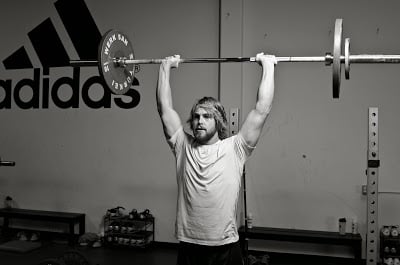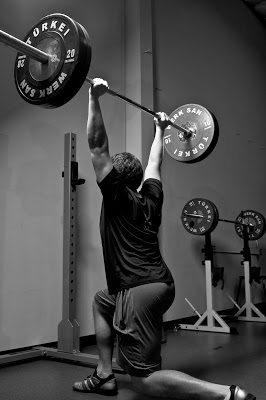
Being weak is dangerous. Inadequate strength, stability, and motor control in a particular movement pattern are the mechanisms of injury. This is especially true at joints like the shoulder where athletes must transfer and control extreme forces. Overhead pressing is a great way to develop strength, however it has become a controversial topic in strength training circles.
Many argue that the risks do not outweigh the benefits. This type of risk analysis is an important part of evaluating every movement in your program, but it should be considered in parallel with several other factors like objectivity, scalability, and universality. Each of these criteria should add up to the ultimate metric of effectiveness; which is how the movement affects an athlete’s Sparta Signature.

Overhead pressing scores very well in the categories of objectivity, scalability, and universality. It is objective in that there is a clearly defined range of motion (collar bone to full extension). It is scalable in that the load is easily measured over a wide range. And it is universal in that it can be performed anywhere with very minimal equipment (barbell, dumbbell, or even body-weight handstand push ups).
So, the objective measures of overhead pressing are very good, but what about the subjective risk analysis? Many athletes have poor shoulder position and posture due to large amounts of sports specific movements (throwing) in addition to the daily activities (sitting, texting, etc.) that affect our bodies. The result is a forward, rounded shoulder position that prevents proper positioning and stability at end ranges of motion. The question becomes, is overhead pressing part of the problem or part of the solution?
Overhead pressing can be a tremendous tool for improving shoulder function because it is a ground based movement that teaches athletes to organize their posture and stability from the bottoms of their feet to the top of their arm. There are however a few prerequisites that are necessary to prepare the body for safe pressing. Soft tissue release and activation for the shoulder and thoracic spine are important for resetting proper body position. Appropriate progressions allow athletes to slowly build up the ability to press properly. At Sparta, we start with a one arm pressing variation with dumbbells before moving to a barbell press.
Brace the feet and hips, and keep the torso in a properly aligned position
Start with a vertical forearm with hand directly over the elbow (angles of GRF always matter!)
Focus on a stable overhead position before lowering weight to the starting position
Pressing, especially the overhead variety, has become a controversial topic in strength training circles because many argue that the risks do not outweigh the benefits. While it is important to mange risk in any training program, it is not wise to completely eliminate a basic human movement. Even more importantly, developing strength through full ranges of motion is a powerful preventative measure against injury.
You should be able to raise your hand over your head, and it should not hurt. Take a close look at the real risks of poor body position and weakness.